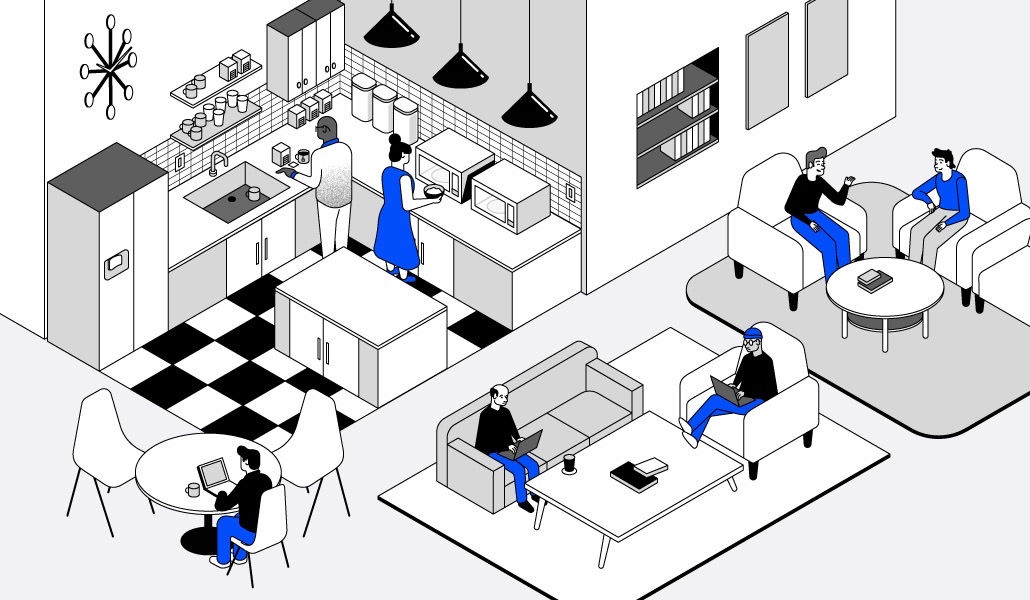How employers are collaborating with staff to make the office relevant again

A full year before the pandemic struck, the San Francisco-based identity and access management company Okta was already rethinking how its office should be structured for new ways of working.
Back in 2019, the company had already introduced something it calls dynamic work, the idea being to create workspaces more conducive to collaboration in general and, when the need arises, areas dedicated to more solitary, focused work, said Kristina Johnson, chief people officer and places at Okta. The redesign called for meeting spaces that accommodate videoconferencing and virtual whiteboards and relied heavily on input from employees.
The remaking of Okta’s workspaces has continued beyond the pandemic and up to employees’ recent return to the physical office — and buy-in on the part of those who work there remains essential to the plan. Employees in the company’s new Paris office signaled, for example, that they wanted it to incorporate inspiring artwork as well as more collaboration spaces, while those in the Tokyo office requested traditional Japanese decorative flourishes as well as a tatami room for meditation.
“We want people to come back to the office, not in the way they used to but for connection and for collaboration. So it’s really important we hear what they think is important in their space and how they’re going to use it,” Johnson said. (She stressed that companies must be intentional when seeking employee input, however, owing to the “survey fatigue” that is a byproduct of the pandemic. Otherwise, as she noted, “Employees will just tune out and not take them anymore.”)
Even as remote and hybrid work have become the norm, companies continue to reimagine their offices with an eye on maximizing productivity, mobility, comfort and aesthetics — with employees in the driver’s seat.
Another company that has rethought the workspace of today is the insurance company Ladder, based in Palo Alto. On the product side, the company prides itself for always thinking about placing the user at the center and building around them, as vp, marketing Olivia Borsje said. So, it applied that principle to its employees when it came to refashioning the office. “We said, ‘Let’s understand what they want, especially in this new world, and let’s build around them,’” she said. “What was really fun was, we had the opportunity to be really intentional with it.”
Ladder found that employees wanted different things in a new workspace and worked to accommodate those disparate visions. “Some people wanted a lot of conference room and whiteboards and other people wanted some quiet spaces that were kind of loungy,” she explained. “Some people wanted their traditional desks, and others wanted a collaboration hub for brainstorming. So, we were able to design a space in a way that allows all these little pockets to exist together, so that you can kind of find your happiness regardless of what your working style is.”
Commuting benefits, which always existed at the company, were also enhanced for employees who choose to work remotely.
“The way we thought about it is, you can’t, especially in this day, force people to come back to the office, so the office has to become a destination, it has to become somewhere that you want to go,” Borsje said. “And if you’re not going to listen to your user — in this case, our employees — and understand what it is that they want, you might miss the mark and open up an office that’s going to be empty. So, it was central to us to get their input, to understand what people wanted and to make sure we delivered exactly on that, and continue to gather feedback.”
It would be hard to imagine anyone with any better perspective on the evolution of the workplace than Peter Miscovich, managing director of the consulting firm JLL and co-author of the book The Workplace You Need Now: Shaping Spaces for the Future of Work. Miscovich has been in the trenches of workplace transformation for more than two decades, having worked with companies including Google, Accenture and Citigroup. Along the way, he has helped transform more than 1.5 billion square feet of commercial real estate.
Needless to say, with offices everywhere in the full swing of reopening, Miscovich is busier than ever.
“For years we designed work around location, we designed work around the office, we designed work around the organization,” he said. “Now, the more sophisticated and progressive organizations are taking a human-centric approach. … And now the challenge is, how do we operationalize this new human centric model? How do we make it work both for the individual, the cohorts of individuals, and for leaders?”
Even though employees are in an unprecedented position of power when it comes to how and where they want to work, Miscovich said he’s talked to leaders of Fortune 500 companies who continue to insist that our new ways of working will wither away and traditional routines will return — despite ample evidence that will never happen. “The pandemic,” Miscovich added, “has blown all that up.”
He pointed to a recent study from McKinsey and Ipsos, based on a survey of 25,000 workers in the U.S., that revealed 58% have been given the opportunity to work from home at least one day a week, while 35% have the option to work from home five days a week. The study noted that survey respondents work across a range of sectors, in different regions of the country, and in “blue collar” as well as “white collar” jobs. When people get the opportunity to work flexibly, 87% take it, the study showed.
In its recent study, the consortium Future Forum found that employees continue to want flexibility, in both work location and schedule, and are willing to change jobs to gain more control over where and when they work. Every three months, Future Forum surveys more than 10,000 knowledge workers in the U.S., Australia, France, Germany, Japan and the U.K.
Echoing Miscovich’s observation, Future Forum stressed in its latest report that despite current work trends, many companies still fail to fully grasp the reset that’s been underway for more than two years. “Employees today are increasingly seeking greater flexibility at work, yet employers are under-delivering,” it said, adding that the rise of new Covid variants “may push this issue to a breaking point.”
The study also found:
- Only 1 in 5 knowledge workers want to be in the office full-time, the lowest in two years of surveys. Meanwhile, 1 in 3 are working full-time from the office, suggesting return-to-office mandates are creating friction.
- 80% of employees want location flexibility, while 55% want to work from the office two days a week at most.
- 94% want the flexibility to set their own schedules. Employees with little to no ability to set their own hours reported more than 3 and a half times worse work-related stress/anxiety and more than 2 times worse work-life balance.
- 55% are open to looking for a new job in the next year — a figure that jumps to 70% among those who say they are dissatisfied with their level of work flexibility.
“Today’s workplace environment is centered around flexibility, and employees without it remain at a strong risk of attrition,” said Brian Elliott, executive leader of Future Forum. “Companies looking to build productive, successful teams need to think about how they provide flexibility not only in where but also when people work.”


